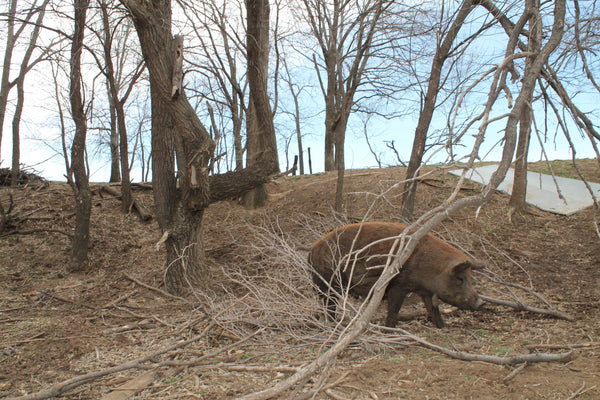
The Red Wattle — A Gastronomic Polyglot
Across cultures and time, the breed of pig that today goes by the name Red Wattle, but which has existed in some form for centuries by other names, has been taken around the world by foot, boat, train, and truck! Red Wattles are known for their hardiness, foraging activity, and rapid growth rate, but many pigs boast these traits. What was it about this pig that made it such a celebrity?
The Wattles ancestor can be traced to China, as all domesticated pigs can be, where it was eventually boarded onto small long-voyaging ships destined for the South Pacific. Centuries later, it again took up cherished spots on boats, this time French ones, bound for New Orleans where it became the pork of choice for Creole and Cajun chefs, at the same time when jazz was being created as an art form. Years later the pig was allowed to roam almost wild in the forests of Texas. Then it was reported extinct. But somehow it survived. In the 2000s the Red Wattle would become a household name among chefs — again — for its meat quality.
The history of the Red Wattle can be traced back 1,000 years or more. The wattles — fleshy protuberances that hang from its jowl — are a signature feature, along with its cinnamon colored skin, allowing the breed to be recognized over time. All pigs used to have wattles, but today the Red Wattle is one of the very last varieties left in the world to retain the trait that is carried by a single gene.
There is a theory that this pig came to the US from the Spanish, but most think the breed came here from New Caledonia, including the most definitive source for all things livestock, The Encyclopedia of Historic and Endangered Livestock and Poultry Breeds by Janet Vorwald Dohner. This makes the breed the only breed of pig in the US that we know about that did not arrive here by way of Europe. The peoples of the Pacific Islands have a long history with pigs, a livestock deeply woven into their cultural food traditions. Even the Disney character Moana had a pet pig! But New Caledonia is a remote island, about 750 miles from Australia, with no native livestock. So where did the ancestors of the Red Wattle originally come from?
Wild boars are native to many places. Domesticated pigs were developed in China and spread throughout the world including to New Caledonia. Pigs moved through active trade routes and when Chinese settled in new places, bringing their food culture with them including breeds of ducks and ancestors of the Red Wattle. Documentation exists showing Chinese migration to Southeast Asia by the 10th century, but as early as the 3rd century, barbarian invasions in the wake of civil war, plague, and famine led to entire communities moving south. Chinese of later eras, as well as other groups, also conducted oceanic voyages into the Pacific including the Neolithic Lapita culture — or Austronesians — beginning around 1500 B.C. Around 1200-1500 years ago the Polynesians brought more pigs, the Kunekune (which also have wattles) being perhaps the most famous.
Whether our Red Wattle predecessors arrived to the Pacific one, two, or three millennia ago, either way, they had been there for a long time. As the centuries rolled on, before Europeans arrived, the Melanesians of New Caledonia selected, developed, and some would say perfected the physical and taste characteristics of the Red Wattle — they made it their own. We can see how good a job they did by the fact that the journey of the breed around the world was in some ways just beginning.
The first European to arrive in 1774 was the British navigator James Cook, who christened the country “New Caledonia” because the mountainous scenery of the main island reminded him of his native Scotland. Red Wattles might have been brought to the Americas between Cook’s arrival and 1846. During this span, the Northwest Company and Hudson's Bay Company merged, creating three new trading regions: New Caledonia, Thompson River Watershed, and Columbia District. But by 1846 the British relinquished any claim to territory south of the 49th parallel in signing the Oregon Treaty.
More plausibly the Red Wattle came to these shores by way of the French. In 1853 France took possession of most of present-day New Caledonia with the aim of reserving the territory as a possible site for a penal colony. It is around this moment that the pig arrived in New Orleans, a region of the Americas with deep French roots. Again, the Wattle was going places.
Before the arrival of Europeans, there existed no domesticated livestock on these lands — only wild animals like bison (and the turkey, which many Native groups did actually domesticate). Most livestock were brought here when the Spanish, Dutch, English, and French arrived from Europe during early expeditions starting in the 16th century. The Spanish Churro lamb is credited as being the first domesticated species to land here (soon after which the Navajo peoples turned it into an integral part of their culture), and many others followed including pig varieties like the Berkshire, Gloucestershire Old Spot, and Tamworth. But not the Red Wattle — it came later and by way of Asia and the South Pacific.
Even with many European varieties available in the Americas at that time, it was the Wattle that would be embraced by the leaders of what is perhaps our greatest gastronomic contribution to the world, along with BBQ: Creole and Cajun cuisine. Once in New Orleans it quickly became a favorite meat breed and would come to populate backyards, serving as a backbone to any recipe calling for pork.
Then, remarkably, the history of the Red Wattle gets murky — again. Once their celebrity moment in New Orleans ends, they next appear in the forests of east Texas where the breed was known as woods hogs. Ranchers had found a place for the herds and the Wattle had found a way to survive. From time-to-time the locals rounded the pigs up on horseback using trained dogs and hauled them away to the great slaughterhouses of Chicago. The Wattle pig was important enough — and delicious enough — that it spawned a cowboy/shepherding culture around it, following in the footsteps of cattle and bison. Red Wattle pigs were sturdy, hearty, and adaptable — they were survivors.
As time progressed, the destruction they caused by their rooting led to their near extinction. But a few farmers must have kept them or been aware that some were still out there somewhere. One day in the late 1970s, a Texas pig farmer named H.C. Wengler stumbled upon a clan of pigs roaming around the eastern part of the state, recognizable by their color and unmistakable wattles and he took them in.
A re-re-re-renaissance was afoot! Thanks to Wengler, other farmers took on Wattle boars and sows as well. Larry and Madonna Sorell, who we had worked with for three years already through the heritage turkey project, were among them. They ran the most idyllic farm in Glasco, Kansas, not far from Salina. Tucked into their wild patch of woods and small paddocks lived many rare breeds including Scottish Highlands, Narragansett and Bourbon Red turkeys, Cornish chickens, and a donkey with a bum leg. Madonna was the best cook we ever came across in our travels and her home resembled a doll house even though they had raised ten children in it. The Red Wattle was a perfect addition, roaming their woods, almost feral but still domesticated. Little did they know that those pigs would soon become celebrities.

One day in 2004 we visited Larry and Madonna, soon after having started Heritage Foods to preserve livestock breeds from extinction by selling them. We came with four New York chefs for a side-by-side breed tasting to see which breed we should start growing in larger numbers. That tasting was attended by Mark Ladner, Jason Denton, Zach Allen, and Steve Connaughton. As had happened throughout history, the Red Wattle was singled out.
Next came a handshake and a commitment to launch something together even if it would take years to accomplish — breeding pure Red Wattles takes time. Larry and Madonna combed the Midwest buying up Red Wattles from farms and loading them on their truck to take back home to start a rare breed herd that would eventually be anchored by a consortium of their local Amish.
Today the farmers raise, and we purchase, about 75 Wattles each-and-every week of the year, a small number in the grand scheme of things but a significant number in the rare breed world. The non-profit Livestock Conservancy lists the Red Wattle as Threatened: breeds with fewer than 1,000 annual registrations in the U.S. and an estimated global population less than 5,000.
Over subsequent years, the Wattle herd grew and would come to populate menus at great restaurants across the country. At NYC’s Lupa Restaurant the boston butts were the main ingredient for some of the best pasta sauces in the nation. Brooklyn’s Vinegar Hill House would feature the Red Wattle country-rib chop, called out by New York Times food critic Frank Bruni as one of the best bites of his career. The Fatted Calf produced a beloved all Red Wattle salami with black pepper and Spanish Pimenton. And Romy Drohan, chef and owner of Filipino restaurants Purple Yam and Cendrillon used the Wattle exclusively for his traditional holiday centerpieces, like the bone-in skin-on belly for leçhon — he was drawn to the Wattle, not knowing that its origins were close to his own! Other great chefs adored Red Wattle pork as well. Once again, this pig had found a place for itself in the food supply. A recent article by Saveur Magazine was titled, “Is the Red Wattle America’s Tastiest Pig?”
Over the years we have conducted many tastings trying to determine what Red Wattle tastes like. Remarkably the Wattle seems to have acquired a taste and flavor from each of the stops along its global journey. We have used the words "charmingly inconsistent" to describe it — always Wattle but never exactly the same each time. Its meat is always full of surprises! Farmers obviously have something to do with this since they select the traits that will be bred into the next generation. But, perhaps romantically, we believe the pig itself simply excels in flavor and in its ability to adapt to local traditions.
We have called Red Wattle pork sweet, nutty, floral, robust, concentrated, bold, melt-in-your-mouth, and tender. We’ve also used words like porky, wild, more like a steak, murky, breezy, swampy, forest-ey, brackish, and bayou-ie, not exactly the best marketing words to describe the taste and flavor of pork but all are undercurrents to each bite — with no one taste ever going too far that it falls out of favor. In the end it’s just a superior pork chop.
For a livestock breed to make it in this world, it has to be eaten, and the Red Wattle has been eaten for thousands of years. It’s a polyglot, a product of many gastronomic languages. It’s a celebrity and a survivor. And we are thankful for it.
